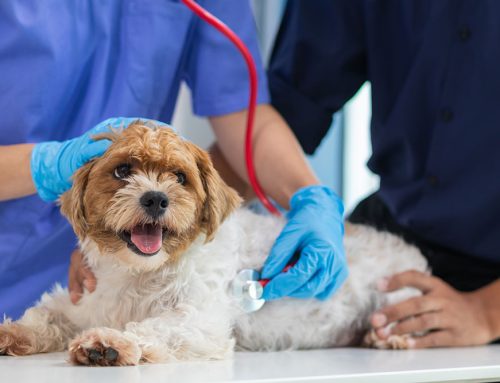When you receive a reminder that your pet is due for their vaccinations, you may wonder what the abbreviations stand for, why your pet needs vaccinations, and what vaccinations will protect your pet against which diseases. Our Liberty Veterinary Hospital team wants you to know how vaccinations safeguard your pet against infectious disease, so read on for our pet vaccination guide. As an AAHA-accredited veterinary hospital, we follow the American Animal Hospital Association’s guidelines for vaccinating pets.
What is the difference between core and non-core vaccinations?
Your pet likely requires a combination of core and non-core vaccinations. Every pet receives core vaccinations, which are essential for halting highly contagious and serious illnesses in their tracks. Pet owners are most familiar with the rabies vaccination as a core vaccination, but other, species-specific vaccinations and non-core vaccinations may be needed. Non-core vaccinations are based on a pet’s lifestyle and exposure risk and each pet may need different ones.
What vaccinations do dogs receive?
Your dog’s vaccinations will vary based on whether they need one- or three-year vaccines, and the non-core vaccinations they need. Core vaccinations for dogs include:
- Canine adenovirus-1 (hepatitis) — Often called canine infectious hepatitis, adenovirus-1 affects the liver and mostly severely affects young puppies. Dogs who recover from hepatitis may develop blue eye, a corneal cloudiness, and they can continue to shed the virus for six months or longer in their urine.
- Canine distemper virus — Distemper can lead to respiratory, gastrointestinal, and neurological issues, and often leaves survivors often with lifelong neurological conditions. Distemper is sometimes referred to as hardpad disease, because affected dogs can develop thickened tissue on their paw pads and nose. Transmission occurs through contact with saliva, urine, feces, or respiratory secretions from infected dogs.
- Canine parvovirus — Parvovirus, or parvo, is an incredibly contagious virus that can rapidly spread through litters of unvaccinated puppies and be fatal without treatment. Parvo attacks the intestinal tract, and in some cases, the bone marrow. The most common signs include vomiting and hemorrhagic diarrhea. Transmission largely occurs through fecal contact, and the virus can linger in the environment for months to years.
- Leptospirosis — The bacteria that causes leptospirosis is spread through an infected animal’s urine. Pets can encounter the pathogen if they swim in or drink water contaminated by infected wildlife. Leptospirosis causes kidney and liver issues, and the infection can be passed to people through an infected pet’s urine. Although the leptospirosis vaccine is not considered a core vaccine in all areas, the disease is endemic in Ohio, and we recommend the vaccine for all dogs.
Non-core vaccinations given to your dog based on lifestyle include:
- Lyme disease
- Bordetella bronchiseptica
- Canine influenza
What vaccinations do cats receive?
Whether your cat never ventures a whisker outdoors, or they enjoy being leash-walked around your neighborhood next to your dog, they require a core set of vaccinations, and may need non-core vaccinations, based on their risk. Core vaccinations for cats include:
- Feline herpesvirus-1 (feline viral rhinotracheitis) — Herpesvirus in cats is a common cause of severe upper respiratory disease, and the leading cause of conjunctivitis in cats. When stressed, a previously infected cat can become ill again, without being reinfected. This disease is spread when infected cats sneeze and send aerosolized droplets into the air, or through contact with a contaminated surface.
- Feline calicivirus — Feline calicivirus causes upper respiratory infections and oral ulcerations. Differentiating between calicivirus and herpesvirus is impossible based on clinical signs alone. Calicivirus is thought to be associated with chronic stomatitis, a painful inflammation of the gums and oral tissue.
- Feline panleukopenia — Panleukopenia in cats is similar to parvovirus in dogs, and has a high mortality rate in young, unvaccinated kittens. This virus typically causes diarrhea, vomiting, and depression, and also attacks the white blood cells, leaving your cat vulnerable to secondary infections. The virus is spread through contact with saliva or feces, and can also be transmitted indirectly through contaminated surfaces.
- Feline leukemia virus — Feline leukemia attacks the immune system and can lead to anemia and cancer. Since the virus weakens the immune system, cats typically develop severe secondary infections, and often succumb to the disease within three years of diagnosis. The virus is usually transmitted from cat to cat through a bite, close contact, and sharing food dishes and litter boxes. Also, mothers can infect their kittens.
Non-core vaccinations given to cats are based on their lifestyle and exposure risk, and include:
- Feline leukemia virus for cats older than 1 year
- Chlamydia felis
- Bordetella bronchiseptica
Rabies vaccination for cats and dogs

All pets should be vaccinated for rabies, both as a human and animal health concern. A stringent vaccination protocol in the United States mandating that all domestic pets be vaccinated has virtually eradicated this deadly virus, although wild animals still carry the disease and can infect unvaccinated pets, generally through a bite.
Rabies is a viral infection that attacks the nervous system and causes brain and spinal cord inflammation. Signs can vary, but may include behavior changes, light sensitivity, inability to swallow, drooping jaw, and seizures. Once clinical signs appear, rabies is fatal.
Since pets can contract so many serious infectious diseases—and some can be transmitted to people—regular vaccination is essential to keep them safe and healthy. Don’t let your pet’s vaccination protection lapse—schedule a wellness visit with our Liberty Veterinary Hospital team.








Leave A Comment